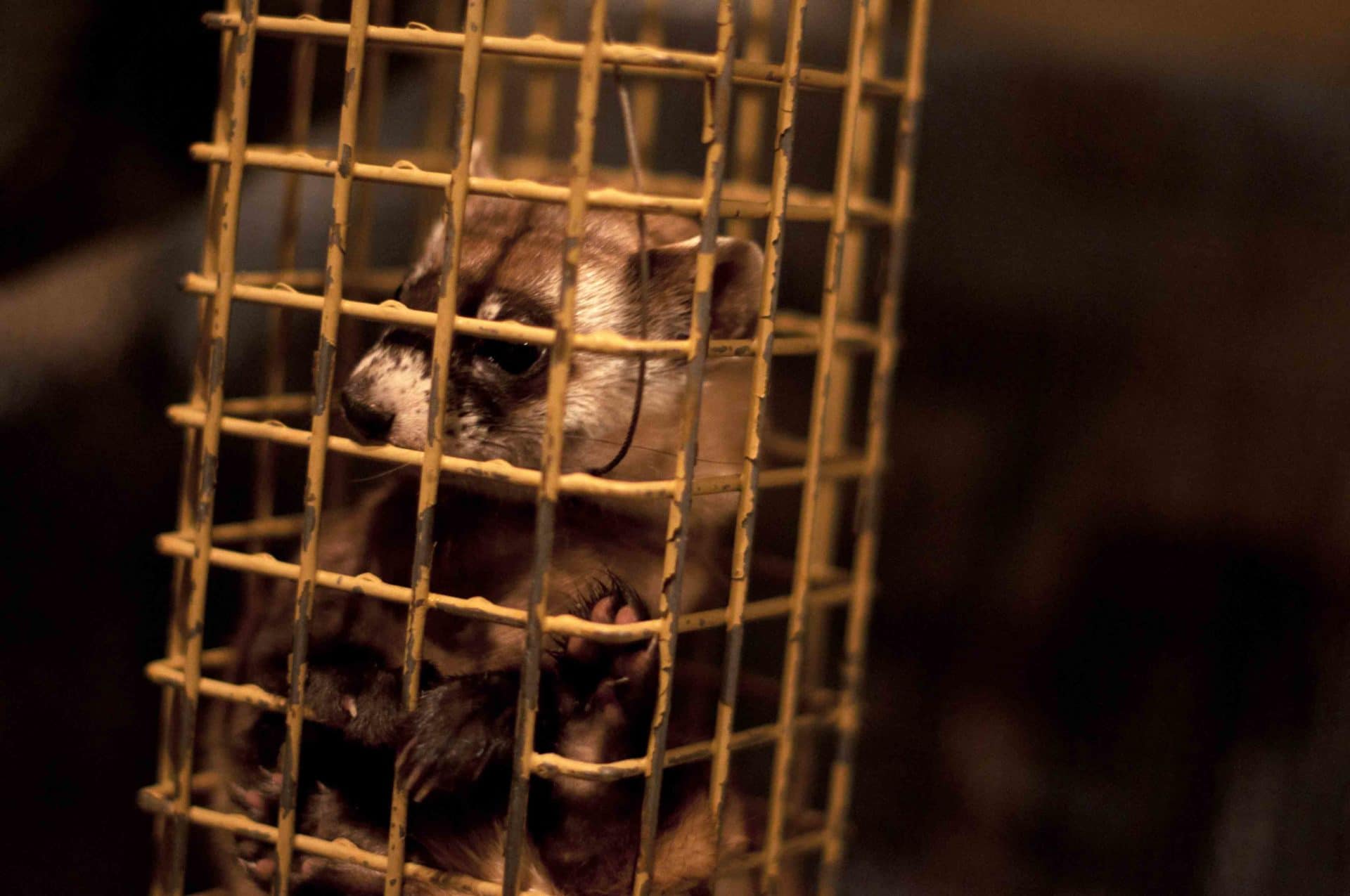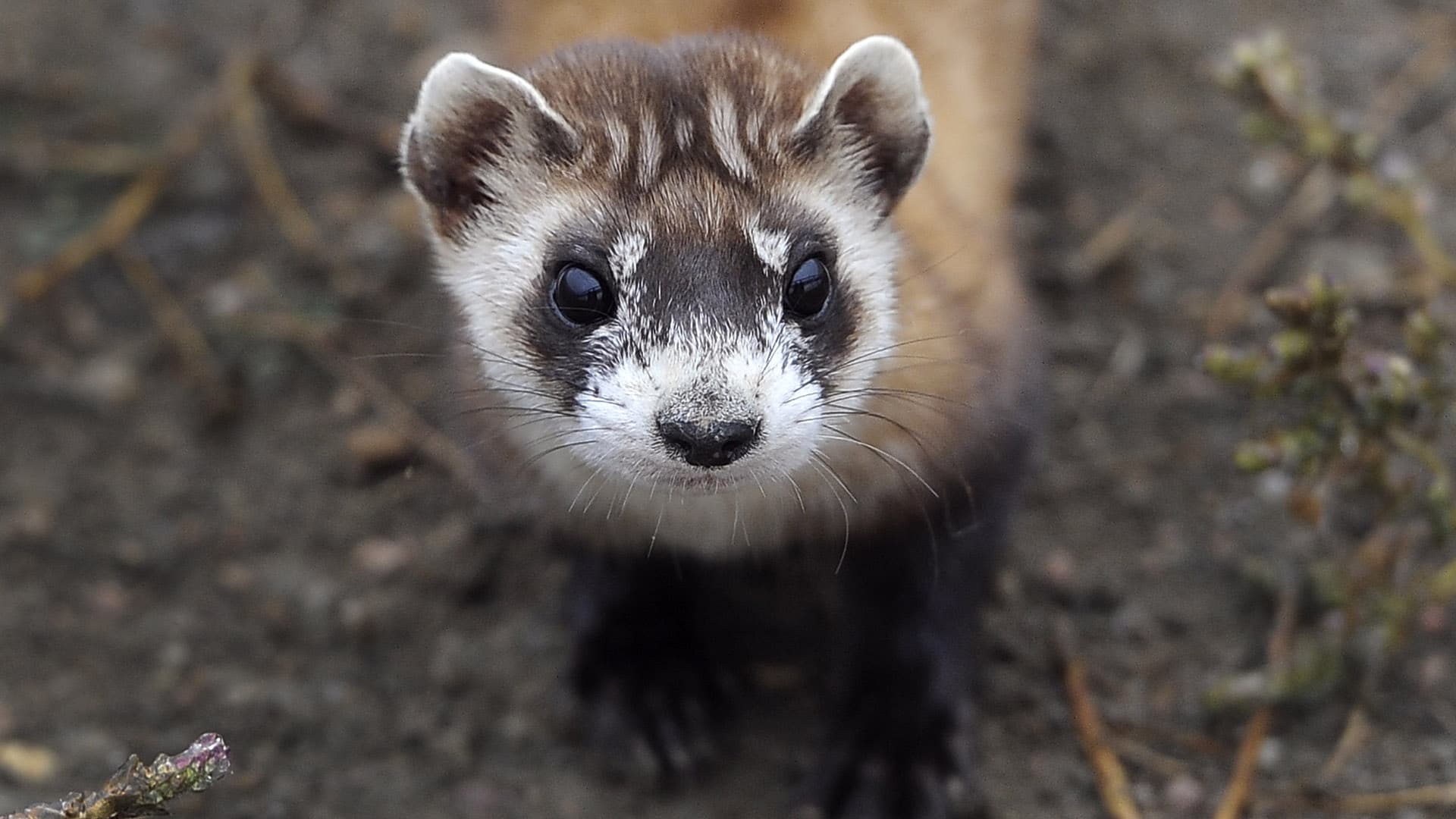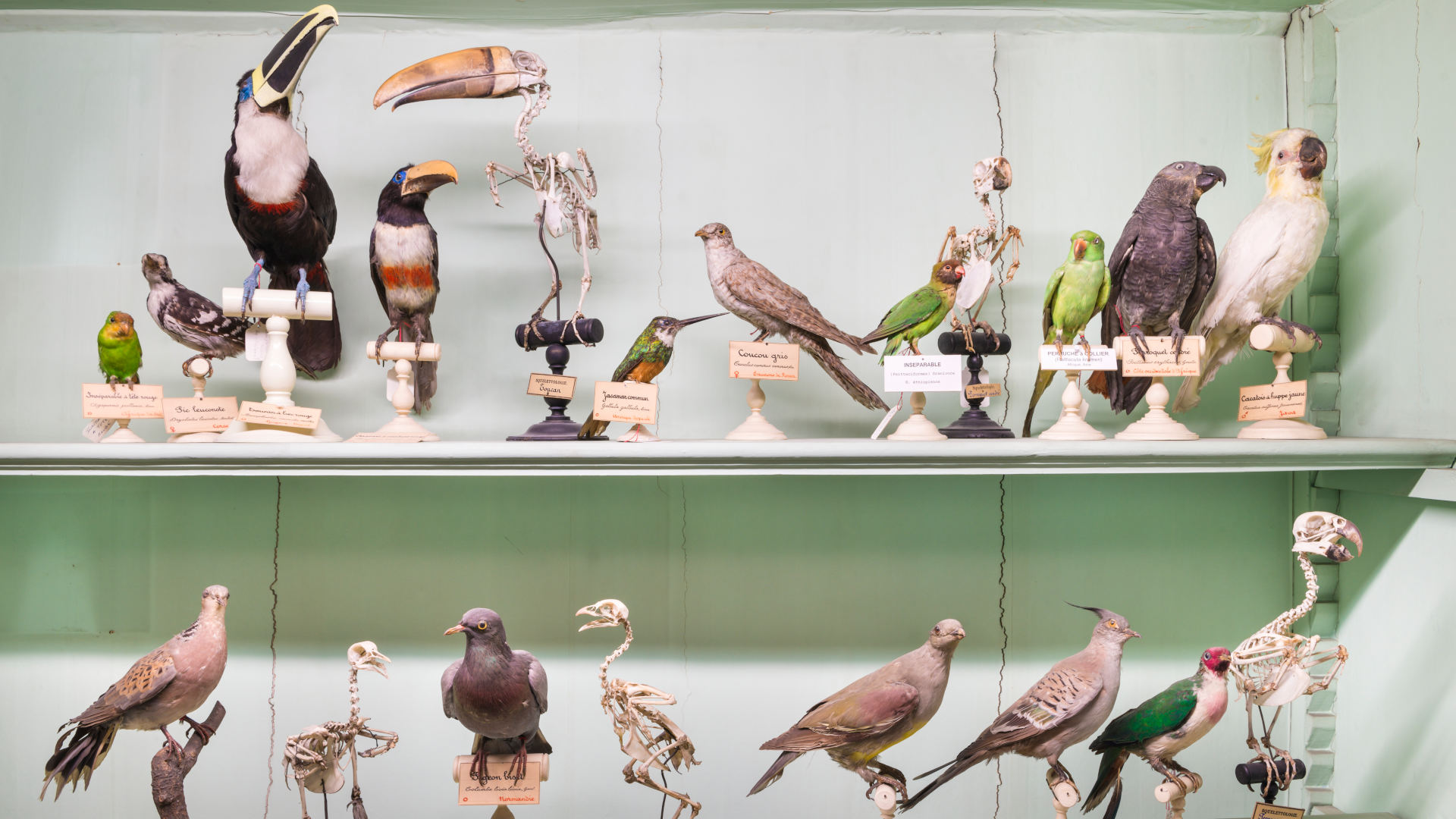The Race to Conserve America’s Black-Footed Ferrets
The night was settling from cool to downright cold as Holly Hicks drove out into the northern Arizona grasslands with an endangered black-footed ferret in her backseat. It rode in a pet carrier lined with paper shavings during the three-hour drive from Phoenix, where it had been recently treated for injuries. During a brief layover at a house that serves as headquarters for Arizona Game and Fish Department black-footed ferret recovery staff, the animal peered out through the grate and chattered.
At around 8 p.m, Hicks, a biologist, put on an additional layer of clothing and a warm hat before grabbing the pet carrier and heading out for her workday. The mid-October weekend was one of four each year when staff and volunteers stay up all night driving dirt roads with a high-powered spotlight shining out the window, scanning for the green eye shine that signals a black-footed ferret staring back. Lately, many teams have come back with zero sightings.
Arizona’s Aubrey Valley hosted some of the first ferrets returned to the wild in a program that now spans 30 sites across North America. Back in 2010, the U.S. Fish and Wildlife Service declared that early reintroduction a success, and two years later, Aubrey Valley’s ferret population peaked at 123. But then, the once-successful endangered species reintroduction site suddenly began losing its ferrets. Researchers are struggling to figure out why. As part of a “survivability study” that asks whether the species can even still live in northern Arizona, biologists released 24 ferrets — including Hicks’ travel companion — into the valley this past fall and closely monitored them.
Jennifer Cordova, a wildlife specialist with the Arizona Game and Fish Department who leads ferret program work in the Aubrey Valley, says she has seen ferrets elsewhere in the area, but that they seem to be missing from the valley itself. They might be dispersing out of the recovery area, dying from disease, starving, or becoming prey themselves. Research is underway to track the possibilities, but the last few years have been as much about figuring out which questions to ask as about answering any of them.
When species become critically endangered or vanish from their historic habitat, the U.S. Fish and Wildlife Service deploys reintroduction programs to restore those animals. There are some success stories. Back in 1987, a captive breeding program for California condors started with just 27, and the wild population is now estimated at nearly 300. Since wildlife managers in Colorado released 96 Canada lynx in 1999, their population has reached more than 200 in the state. Sometimes these species even enjoy banner successes, like gray wolves becoming so abundant in the northern Rocky Mountains that the population was removed from the endangered species list. But other cases, like red wolves and Mexican gray wolves, have fared less well, with wild populations estimated at 40 and 131, respectively.
“I hate to say this, but I think there are quite a few species that are going to need our help,” said Kimberly Fraser, with the U.S. Fish and Wildlife Service National Black-footed Ferret Conservation Center in Colorado. The center’s goal, she said, is to put themselves out of business by having ferrets out on the landscape, living and dying without human intervention. The U.S. Fish and Wildlife Service envisions a population of 3,000 breeding adult ferrets in dozens of colonies across their historic range. Fraser estimates, at best, 500 are alive in the wild now. The number had reached nearly 1,000 by the end of the 2000s, but has since drifted backward.
“When we started out with ferrets, I thought, ‘Boy, this is such a simple system — ferrets are just totally dependent on prairie dogs and it’s a pretty closed system. It’s just something we should be able to gain an understanding of fairly quickly,’” said Dean Biggins, a research wildlife biologist with the U.S. Geological Survey. “Every question we answer regarding how the system functions leads to 10 more questions,” he said. “It’s amazingly complex.”
When Hicks began working on black-footed ferrets in 2016, the Game and Fish Department was finalizing plans to take the relocation effort statewide. Then, the decline in the Aubrey Valley accelerated. Before they could move forward, she said, they had to step back and figure out what was going on with this reintroduction site. Ferrets like her passenger may help answer that question.
Black-footed ferrets are part of the weasel family, with skinny bodies that can reach 24 inches long, including their tails, and weigh just 1.4 to 2.5 pounds. Along with their namesake black feet, black marks on their faces and tails accent their otherwise tan fur. They share a common ancestor with the European polecat, from which the type of ferret found in pet stores was domesticated more than 2,000 years ago to hunt rabbits and control rodents. Once, North America’s prairies may have been home to tens of thousands of black-footed ferrets, but that population dropped as grasslands were converted to farms and plague was introduced from China about a century ago. Both killed off prairie dogs, which make up 90 percent of a ferret’s diet and whose burrows provide its only shelter.
Ferrets are solitary, nocturnal, and spend much of their time underground, said Fraser, so they can be easy to miss. By 1981, the species was thought to be extinct, but then a northern Wyoming rancher’s dog dropped a ferret carcass on his porch. That led to searching the area, where biologists found 130 of them. After disease swept through that colony, biologists captured the last of them to create a total captive breeding population of 18.
For the last three years, Arizona Game and Fish Department biologists have released ferrets wearing radio collars that broadcast their locations. The staff had some hiccups fitting a collar on an animal built like a slinky; some slipped off and some chafed.
In the first two years, the researchers monitored and documented ferrets as they ranged far and wide looking for food (one traveled more than 10 miles in just a couple of nights). When their collars signaled a likely mortality and staff were able to recover the carcass, sometimes digging six feet underground to retrieve it, they found the ferrets died with an empty digestive tract.
In 2019, biologists released some of the captive-born ferrets earlier in the fall, giving the animals more time to learn how to hunt before prairie dogs began hibernating. The biologists also shifted the release sites off the southeast edge of Aubrey Valley and into the nearby Double O Ranch. Biologists are not sure exactly why that change has helped, but finally they are seeing more promising results. Ferrets are staying close to where they were released, and they’re gaining so much weight they’re bursting out of their collars.
“This is the first time I’ve been excited about spotlighting in a few years, because the last few years just have been rough not finding anything,” Hicks said.
Her first stop in the valley was at the GPS coordinates where the injured ferret had been trapped weeks before. When its collar had started reporting little movement, staff set about trapping it to see what had gone wrong. They spotted abrasions caused by the collar, so staff relocated the ferret to the Phoenix Zoo to recover. Its burrow was flagged with a reflector so Hicks could put it back exactly where it had been found. Hicks aimed the pet carrier toward its burrow, lay out a chunk of frozen prairie dog as enticement, and opened the door. The ferret crept back underground, as if a bit baffled by the change of scenery.

After the successful drop-off, Hicks headed down dusty roads to the last known GPS coordinates for another one of the collared ferrets. The Fish and Wildlife Service considers surviving the first 30 days enough to demonstrate likely long-term success. Now, the Arizona staff were trying to remove the collars before their batteries died. Hicks parked, pulled out a hand-held antenna used to pinpoint a collar, and crunched over dry grass and past cow patties, searching for the strongest signal.
“I got it,” she said. A steady, low beep came through the static. She followed it until her light passed over a pair of emerald eyes. They fixed on her as she approached and pointed her headlamp down the burrow. Hicks fetched a trap from the truck, fit it into the burrow entrance, wrapped it in burlap so it would look and feel — at least to a ferret — like an extension of the tunnel, and then shoved plastic cups into surrounding burrow openings to block any back-door exits. About every hour, she returned to check the trap. When a ferret is caught, it’s driven to a nearby RV, where it receives a medical work-up, including vaccination against plague.
Plague often makes its presence obvious. A prairie dog colony is there one day, and gone the next, in what’s known as an epizootic outbreak. That’s contrasted with enzootic outbreaks, which affect only a portion of an animal population. In the Aubrey Valley, coyotes and even a few badgers have tested positive for plague, but not prairie dogs, where its presence would pose a direct threat to ferrets. Captive-born ferrets get a series of shots that give them an 80 percent chance of surviving the disease, but wild-born ferrets have to be repeatedly trapped to receive the full inoculation. Even then, if all the prairie dogs have died, ferrets will starve.
Biggins suspects researchers initially underestimated the threat of plague because they were focusing on epizootic outbreaks. When Biggins vaccinated half a colony of ferrets in Montana, their survival rose 240 percent — a sign that plague had been present even though they hadn’t seen the typical population drop it brings. Now he believes plague is “really difficult to detect, but a really big problem for ferrets.” After part of the prairie dog colony in the Aubrey Valley was dusted with an insecticide that wipes out plague-carrying fleas, that particular area seemed to have a higher density of prairie dogs, according to Cordova. A more formal study launches this year. But it will be time-consuming and expensive — $25 per acre — to cover several thousand acres of prairie dog colony in the Aubrey Valley.
The speed at which these ferrets disappear, Biggins said, suggests there are more problems than plague. Maybe they’re not finding enough food, or maybe they become prey themselves. A lower density of prairie dogs might also mean they’re essentially working harder to make a living.
Last spring, after a ferret sighting was reported on the far side of the nearest town from the Aubrey Valley, Game and Fish Department staff went out with spotlights and found two. “It’s like, are we not looking in the right places?” Cordova said.
In October, the scientists ran a study on whether dogs can be trained to find ferrets. It overlapped with the collar study, so handlers could quickly verify the dog’s accuracy and reward them with a ball to chase, said Kayla Fratt of Working Dogs for Conservation, a nonprofit based in Montana that collaborated on the study. In a small area where they could sniff every burrow, dogs were right 97 percent of the time. On a larger scale, the rate fell to half that.
“Spotlight surveying and using scent detection dogs have basically the same detection rates, but spotlight surveying usually requires three to four nights of surveys, and dogs cover that same ground in four hours and you can survey in the daytime,” said Jesse Boulerice of the Wildlife Ecology Institute, another Montana nonprofit that collaborated on the study.

It all seems a bit like tracing a single thread through a tangle of strings; the researchers run somewhere that might be useful, but miss the sought-after end point. “When you don’t know what you’re dealing with, you kind of start picking different things and experimenting,” Hicks said. “Is there something in the landscape that we’re constantly missing? That’s also quite a possibility. We don’t know.”
Biggins offered advice for other groups working on species conservation: “Try to do proactive things to expand populations before you get into a bind,” he said.
Arizona’s fall count ended with 20, twice what they saw in 2018, but 14 of those were new releases. Research has correlated drought years with fewer prairie dog kits, so after 2019’s dry monsoon season, they likely won’t release more ferrets this year, Hicks said. How the resident population will fare remains to be seen.
Driving to check a trap, Hicks trailed the spotlight beam over knots of sagebrush, a dozen deer, and three skunks. Then she drifted to a stop and watched as a ferret ducked in and out of its burrow, and then turned its green eyes toward her. This one didn’t have a collar on.
“I like surprise ferrets,” she said.
It could be one of the ferrets whose collars were already removed, or it could be wild-born, she said. “If it’s a brand new one that we’ve never caught, that’s super exciting.” The only way to know for certain would be to trap it and check it for a microchip.
Looping back to check on that ferret shortly after 4 a.m., Hicks turned her light onto the field, and groaned, “Oh, man.” Bright green eyes peered from a nearby burrow. The ferret had evaded the trap she had set.
“We’ll try again,” Hicks said. But maybe it was a good sign: “It shows that he’s savvy.”
Elizabeth Miller is an award-winning journalist who writes about wildlife, public lands, and energy development. Her work has been supported by Freelance Investigative Reporters and Editors, the National Press Foundation, and the Banff Center for Arts and Creativity.












Comments are automatically closed one year after article publication. Archived comments are below.
Are these ferrets domesticatable? If so one way of saving them might be to raise a colony for pets. If they are not suitable as pets yeah keep doing what you’re doing.
Yes, all else being equal, we should save every endangered species. But we know the plains ecosystem can get on without the black-footed ferret; it largely has for the past few decades during which the species has been in captive breeding. And there are plenty of other problems that need money. Why should this one stand out?
Please do what you can to save the black-footed ferret. They are Park. Of our babies I have two domesticated ferrets. Love them to death smart as a whip. I’ve got one baby here watch me plug in an outlet and go over there and unplug it. But do what you can to save these beautiful babies. Do not stop what you’re doing. Please keep going with it. They need our help and our support.